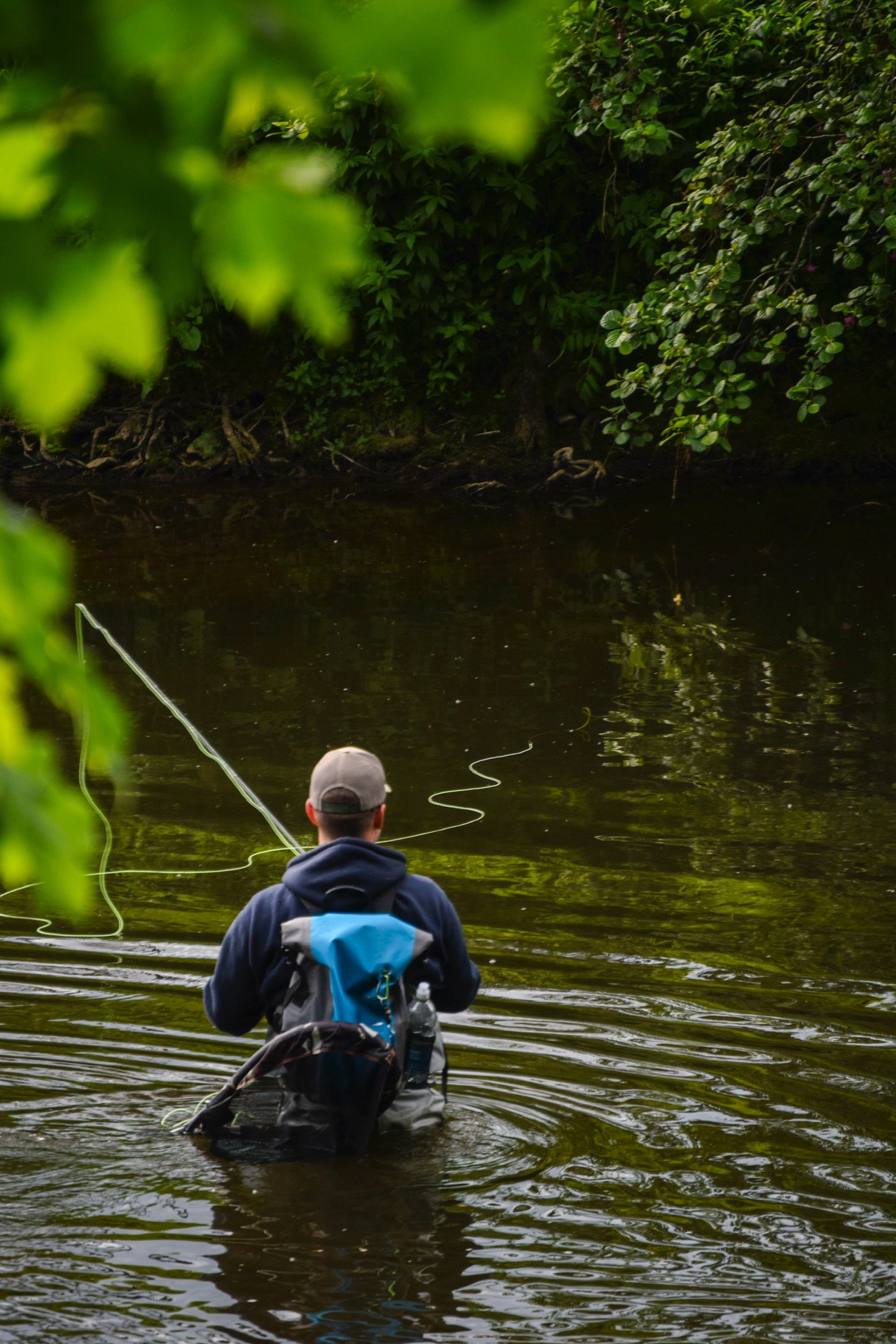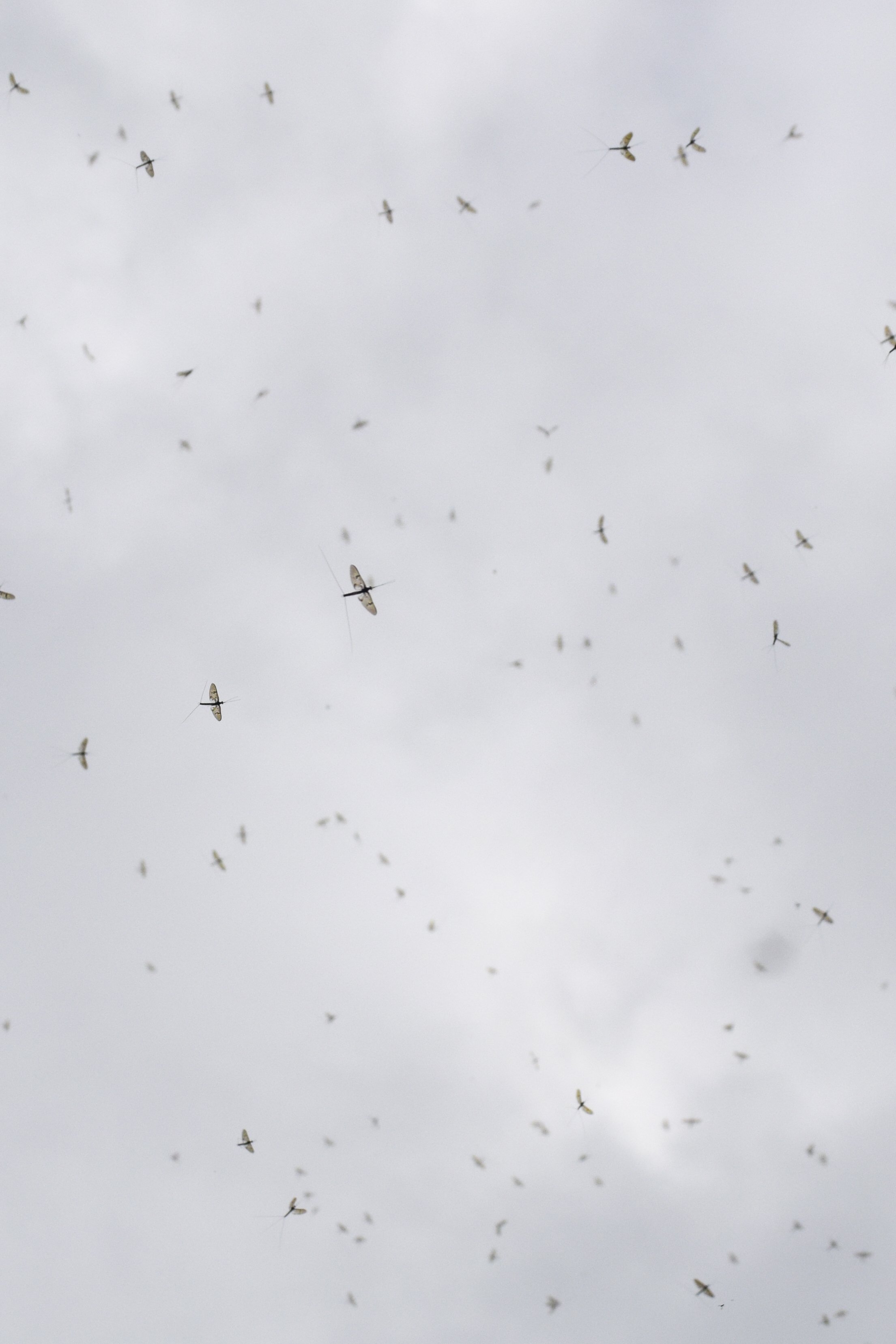
Adam Price-Hunt
1. Choice of equipment Rods, reels, fly lines, fly floatants, clothes, glasses, and other useful items.
My rod choice for any given dry fly situation is simple, the longest rod I can use on the water I’m fishing. Normally, this equates to a 4-weight rod between 9 and 10 feet long with a medium fast action. A long rod allows for better control of long leaders and a greater effective fishing range. The added length is a bonus when bank fishing too, as it helps to keep the rod tip well out over any bankside vegetation.
A reel with a good, smooth start up inertia is a pretty crucial piece of kit too. Fishing with one gives me far more confidence to fish with lighter tippets for specimen trout.
As for the rest of my setup, a clean weight forward floating line to match the rod weight and a good pair of polarised glasses with amber lenses is enough for me to feel confident out on the water.
2. Leader material, build-up, length and knots.
My dry fly leader remains pretty consistent throughout the season. I take a 4x tapered leader of 15 feet and cut it back to the beginning of the taper. With a blood knot, I’ll add around 2 to 3 feet of 5x and 2 to 3 feet of 6x on top of that. Occasionally, I’ll even add some 7x to that, which makes it pretty difficult to fully turn over, but that's the point, I want that extra slack in the cast if I need a better drift to get a fish to take. I prefer a premium monofilament leader and tippet material. I just find it more reliable in smaller diameters and have never felt disadvantaged for not using the more popular copolymer and fluorocarbon options.
3. Approach and stealth.
When it comes to dry fly fishing, I’ll only really start fishing when I see fish rising. I just don’t enjoy the labour of prospecting and much prefer to sit and watch what's going on. You’ll catch much better fish if you're patient and spend a good amount of time just watching and observing before making a cast. When I see a rising fish, I'll move into a casting position and hold off from casting until the fish rises a couple more times. This gives the fish a chance to re-settle from any disturbance you may have caused moving into position and allows you to more accurately decide when and where to cast.
4. Reading the water.
When reading the water to find a rising fish. I don’t focus on guessing where the fish might be, I focus more on where they will feed, which often leads me searching for food sources rather than fish. For example, if I’m expecting a march brown hatch, I'll be looking for a nice riffle at the head of a pool, which is the habitat they tend to hatch out from. If it was terrestrial beetles I thought fish were feeding on, I would focus on overhanging trees tight into the banks. Where fish are feeding can sometimes be affected by factors such as water levels and temperature, but if there's an abundant enough food source somewhere, fish are well practised in capitalising on it.
5. Casting ability which casts are essential.
Guiding people of varying casting abilities has really opened my mind to the importance of functional casting skills. This doesn’t mean you need to be able to pass a casting exam, but it does mean you need to be able to get the fly to where the fish are with a decent level of presentation. Apart from the standard overhead and roll casts, the ability to fish at varying ranges and to shoot low flighted side casts are game changers. On venues with overhanging trees, a low penetrating side cast can put you right into the bank, often where bigger trout reside. As for casting range, people have a habit to default to their comfortable distance zones. In reality, on a river you’ll probably at least need to be able to get the head of a weight forward fly line on the water if you wish to cover the majority of options for dry fly fishing on a river. I must stress though, this should never be at the compromise of a good presentation!
"A perfect drift from a cast with lots of slack on a nice long leader. The long rod makes short work of lifting all of the slack line on the strike if a fish takes")
6. Entomology, what should we know.
$The good news is you don’t need to know your rhodani from your Rhyacophila. However, the more you know about what a fish is feeding on, the better your chances will be of imitating it. Insect type (caddis, mayfly etc), size and colour are the main features you should learn, but I would put behaviour in that mix too. Simply knowing what habitat certain flies like to live in and when they are likely to hatch will save you so much wasted time on your search for feeding fish. Don’t get sucked into the common myths around flies as you're learning the ropes. A good example of one would be, ‘Duns hatch in the day and spinners fall at night’. Believe me, I’ve fished spinner falls in the morning many times and watched duns peeling off well into the evening too!
"A large E.danica mayfly hatch on the Derbyshire Wye. As they dance in the sky, the spinner fall awaits."
7. Rise forms Can they tell us something?
Rise forms do give out some information as to what's going on, but I think it's generally overestimated in terms of what they actually show. They don’t identify what species is rising, which is always a popular phrase that gets thrown around a lot. The information I do obtain from rises includes things such as potential food sources. A fish taking down a hatching caddis will generally be a quicker, vigorous rise, whereas a fish sipping in a spent spinner will generally be slower and much less vigorous, for example. This is just down to the probability of the prey evading the fish's attempt to eat it. To some degree you can determine the size of a fish based on the amount of water that may be displaced by a rise, but I really wouldn't get too hung up on trying to guess. Some of my biggest trout to date have been caught to the more subtle of rises.
8. Fly selection, Size, shape, materials, which flies are essential.
Fly size is so crucial for dry fly fishing. One size either side of the naturals that the fish are feeding on and you could quite easily see your chances of success plummet. Shape, profile size and colour should all really be valued equally in my opinion. By accurately imitating all of these factors you then pretty much leave catching a trout down to having a drag free drift and not spooking it. Sounds easy when you put it like that, doesn’t it! Size is probably the factor I see most inaccuracy in. Most anglers have a tendency to fish sizes that are way bigger than the natural insects they represent. For context, the majority of anglers fish Blue-Winged Olive hatches over here with duns around size 14-16 at times when really they should be down to 20-22 at times. I’m not saying you won’t catch on larger sizes, but it will lower your chances of doing so.
"One of my favourite Olive imitations. A simple, effective Foam Dun using my favourite material, CDC. I tie these in small sizes right down to size 22."
9. Presentation and drifts.
99% of the time a completely drag free drift should be the target. Which is ironic, as anything attached to 15ft+ of fishing line never fully can be. Yes, occasionally a little twitch or skate might get a reaction, but I’d always use that as a last resort after I’ve covered a fish with multiple drag free drifts first. I like to keep drifts short and accurate. There really isn't much point in letting a fly drag off 20 feet past the fish you’re targeting other than waterlogging your fly for the next cast. Slowing down and producing less casts of a higher quality is advice I feel we all could do with remembering next time we are out on the water.
10. Upstream or downstream?
I have no preference for targeting fish from upstream or downstream and neither should you. Each approach will have advantages and disadvantages that should be weighed up in the situation you find a fish rising in. All I would add is, a stealthy and drag free presentation downstream to a fish is a more difficult skill to master and as the fly line and leader butt often flows towards the rising fish you'll have less attempts to get it right before you spook the fish. Choose wisely.
11. Fighting fish.
Get that tip low and get it sideways downstream of the fish. That’s my happy place and where I feel most comfortable during the fight. It takes maximum effort for a fish to fight against you like this and the low tip tends to reduce the chances of fish jumping too. Most importantly though, don’t fear the fight, enjoy it! This is the most exciting part of the whole hobby and I see so many people looking way too stressed out when fighting a good fish!
"A low, downstream rod position applies maximum pressure on to a wild rainbow trout"






